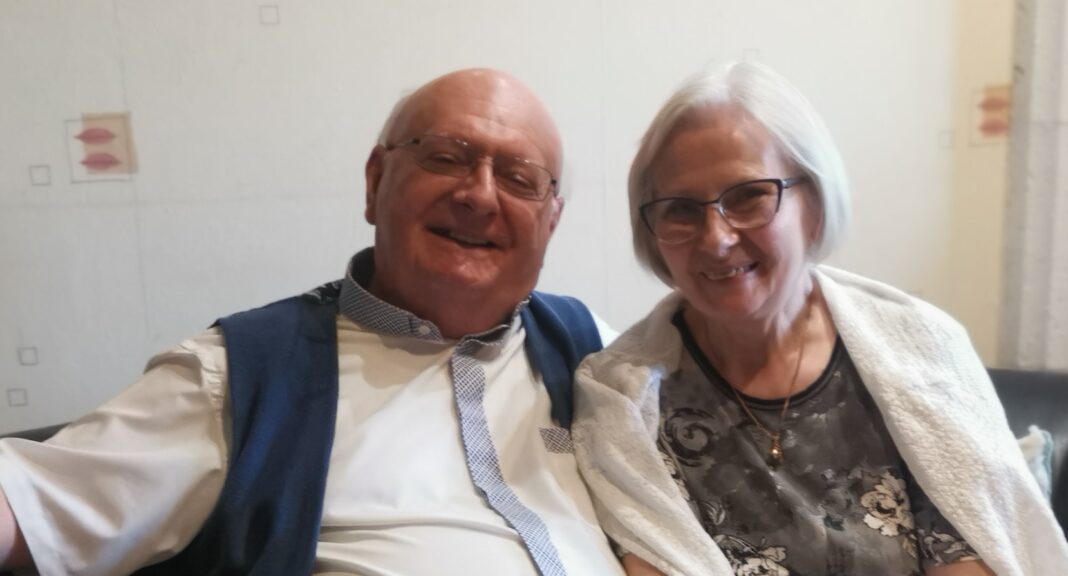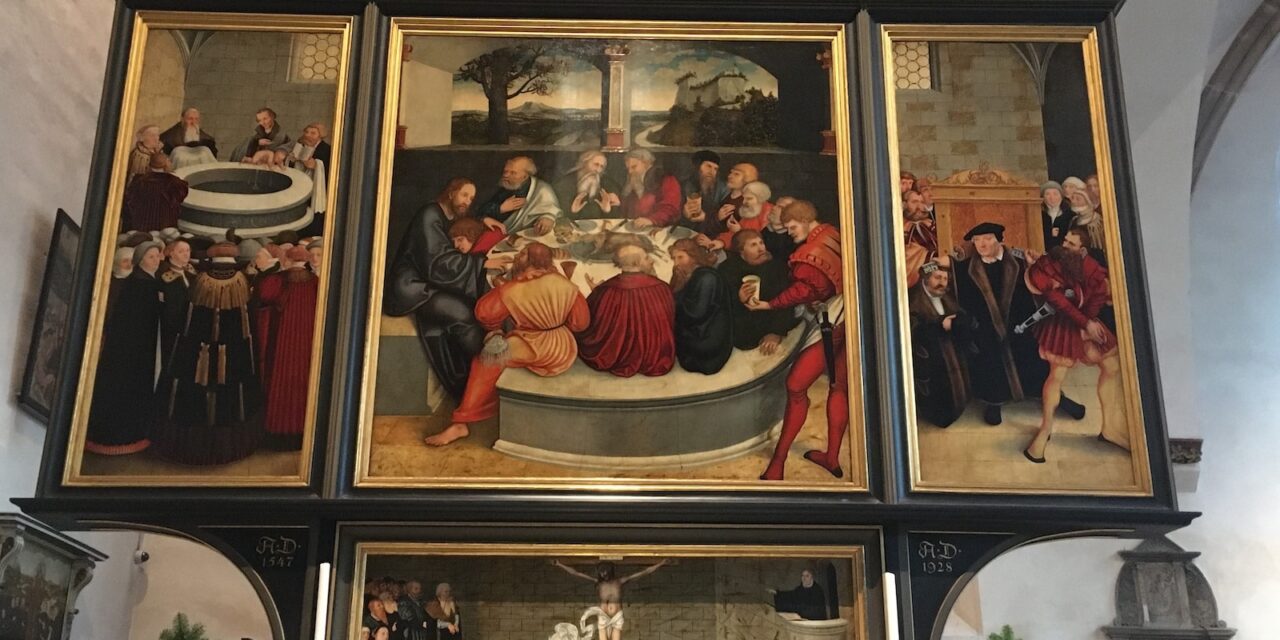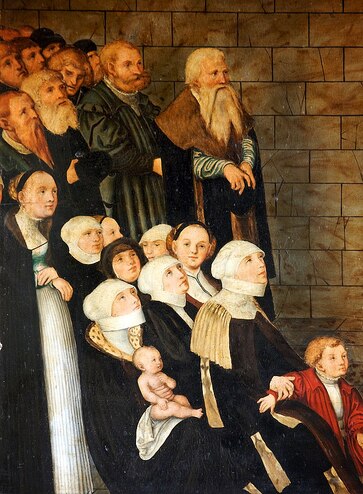"ISTEN-TÜKÖR" - SAJTÓTÜKÖR - A THEO-DIGEST AKTUÁLIS ANGOL, NÉMET, ROMÁN NYELVŰ CIKKEI
„GOTT HAT IN MEINEM LEBEN IMMER WIEDER ETWAS INTERESSANTES VERDREHT“

„Mein Weg war vorgezeichnet, vorgezeichnet“, sagt Dr. Lajos Békefy ist ein reformierter Pfarrer, dessen ökumenischer Dienst in Budaörs begann. Interview von Erzsébet Eller.
„Du warst und bleibst meine wahre Freude, obwohl ich nicht einmal wusste, dass ich dir danken würde. Du, Herr, hast uns Seelen gegeben, Eltern und Kinder, Enkel und Geschwister, Kameradschaft und Umarmungen, Freunde und Lehrer zu Hause und im Ausland, Seelenverwandte, unzählige Gebete für uns und Flehen von ihnen an Dich für mich. Ich bin von hier und darüber hinaus viele Wege bereist, auf dem Seeweg, und Sie haben mir gezeigt: Es gibt nur eine Heimat, jenseits von Land und Land, und dass Sie darauf warten, nach Hause zurückzukehren, in Ihr ewiges Land, dafür danke ich Ihnen immer wieder "
- Mit diesen Worten bedankte sich Dr. für die Anerkennung. Lajos Békefy promovierte am 18. August 2023 mit der Verleihung des staatlichen Ritterkreuzes. Sein jahrzehntelanger Kollege Dr. Und Antal Birkás, Ph.D., Präsident des KDNP Protestant Workshop (dessen Außenminister Békefy 25 Jahre lang war), schrieb:
„(...) wie viele gemeinsame Vorträge, Konferenzen, gemeinsam herausgegebene Bücher, gemeinsam geschriebene Werke, Auslandsreisen, Vorträge, Aufbau politischer Beziehungen.“ Große Straßen, schnelles Tempo – unermüdliche Kreativität. Das habe ich von Lajos erfahren. Diese Auszeichnung ist an der richtigen Stelle! Anerkennung für einen schönen Track ...“
Jedes Mal, wenn ein Feiertag ist, schaue ich normalerweise nach, ob sich unter den Empfängern auch Leute aus Budaörs befinden, und so bin ich auf die obigen Zeilen gestoßen. Ich kannte Lajos Békefy (reformierter Pfarrer, sozialer Aktivist, öffentlicher Schriftsteller, Übersetzer, Forscher, Publizist, Außenminister der Protestantischen Werkstatt, Chefredakteur der Neuauflage von Presbiter Lap) nicht, aber schon seit einiger Zeit kennt er ihn ehrte den Budaörsi Napló, indem er von Zeit zu Zeit die verschiedenen, hauptsächlich seine in theologischen Publikationen veröffentlichten Schriften, hauptsächlich biblische Aufsätze, verschickte.
Dann erfuhr ich von ihm, dass er, obwohl er 1948 in Csorná geboren wurde und dann in Győr lebte, 1971, als er noch sehr jung war, mit seiner ersten Frau nach Budaörs zog. Seitdem lebt er hier, und zwar seit mehr als dreißig Jahren mit seiner zweiten Frau, Klaudia Röhrig, der Mutter der beiden erwachsenen Töchter und Enkelkinder. Beide sind reformierte Pfarrer, mit einer gemeinsamen Weltanschauung, ähnlichen Werten und sogar gegenseitigen Bekanntschaften und doch haben sie erst über Umwege zueinander gefunden.
Ihre Schicksale sind ähnlich, denn neben der Anerkennung gab es für beide auch Ablehnung und unverständliche „Strafen“. Aber vor allem hat Lajos Békefy – nach oben weisend und hinzufügend: mit Gottes Hilfe – immer versucht, den Zeiger für sich und ihren Dienst voranzubringen. Ich danke Gott für die Führung und natürlich für die gewonnenen Erkenntnisse.
Lassen Sie sich jedoch selbst davon erzählen! Um diesen Artikel zu schreiben, luden sie mich in ihr Domb utca-Haus ein, eine kleine Plattenwohnung, in deren Schrank die Reliquien, darunter die neuesten und älteren Auszeichnungen und Diplome, aufbewahrt werden, zum Beispiel die hoch angesehene „Gedenktafel für Strafvollzugsdienst Dr. An Lajos Békefy, einen Beamten und Kaplan der Nationalen Strafvollzugsanstalt Pálhalma seit 2010. Und die von ihm geschriebenen Bücher in den Regalen (darunter 15 eigene und etwa zwanzig Übersetzungen) zeugen von einem reichen Leben. Apropos Auflistung: Fügen wir noch die bisher über 4.200 veröffentlichten Artikel hinzu, die wir allerdings bereits in den Online-Archiven recherchieren können.
Als wir diesen Termin für das Gespräch vereinbarten, schrieb er, dass er nun für zwei Wochen zu Hause sei, danach aber wieder abreisen werde, diesmal nach Rom, in den Vatikan, wo eine weitere Forschungsarbeit folgen werde. Kannst du mir davon erzählen? - Ich habe versucht, mich nach dem Kennenlernen auf das Interview zu konzentrieren. Die Antwort hat mich jedoch sehr überrascht, da es sich um den Völkermord an den Armeniern durch die Türken vom Sommer 1915 bis zur Jahreswende 1917/1918 handelt, den Lajos Békefy vor mehr als fünf Jahren auf Ungarisch zu untersuchen begann.
Nein, er hat keine armenischen Vorfahren, aber da über dieses traurige Ereignis nur sehr wenig bekannt ist, da nicht jeder unter den Armeniern selbst damit konfrontiert ist, warum wurden sie nach seinem Wissen aus den Dörfern und Städten verschleppt und getötet? 1.3 Millionen Menschen, Lajos Békefy, er lässt es nicht ruhen. Und in den Archiven des Vatikans erwartet er reichhaltige Unterlagen aus Berichten und Hintergrundmaterialien zum Briefwechsel zwischen dem Papst und dem türkischen Hof. Das Ziel ist, daraus ein weiteres Buch zu machen.
KEHREN WIR JEDOCH ZUM LEBEN VON LAJOS BÉKEFY ZURÜCK, ODER BESSER GESAGT ZU SEINEN ANFÄNGEN!
„Ich wurde in Csorna geboren und habe mütterlicherseits schweizerisch-österreichische Vorfahren, sodass meine Großmutter Ungarisch lernen musste. Aber in seinen Abendgebeten träufelte er mir auch den guten Geschmack der persönlichen Bedeutung des deutschen Wortes in die Seele. Und auch heute noch, nach vielen tausend Seiten Textübersetzungen, hat dieses Wort noch den Geschmack meiner Großmutter. Und väterlicherseits sind seit Jahrhunderten steinharte Kuns in meiner Seele, kirchenliebende Kun-Vorfahren, bereit, ständig zu protestieren: Wir sind ungarische Calvinisten! Gemäß dem kollektiven Traum unserer Kun-Spezies wollte mein Vater schon immer eine Kirche mit weißen Wänden bauen, zuerst auf dem fruchtbaren, schwarzen Ödland von Karcag und dann in der südlichen Region.
- schrieb er vor fünf Jahren anlässlich seines siebzigsten Geburtstages auf Anfrage.
Dann fuhr er fort:
„Das war alles, was ich tun konnte. Ich konnte drei Kirchen bauen. Ein kleines Kirchenschwein mit den Leuten von Pesterzsébet-Szabótelep. (...) Und zwei Gefängniskapellen im Riesengefängnis in Pálhalma, wo ich fast zehn Jahre lang eingesetzt war(...)“.
Als Antwort auf meine Frage, warum er schließlich Pastor wurde und nicht, sagen wir, Anwalt, Arzt oder Psychologe, wie seine Eltern ihn vorgesehen hatten, erinnert er sich:
„1964 kam ich über die Freunde meines Vaters nach Schweden. Erstaunt über die neue Welt, nahm mich die freundliche Familie eines Sonntags mit in eine katholische Kirche in Malmö. Es war wie eine schwebende himmlische Arche mit seinen weißen Wänden und dem Mast eines Schiffes, der von oben auf dem Kirchplatz hing. Ich weiß nicht wie, nur warum: Ich fiel auf die Knie, Raum und Zeit verschwanden, ich erlebte ein fantastisches inneres Leuchten, der Kirchendiener musste mir auf die Schulter klopfen und sagen, dass die Messe vorbei sei und ich weitermachen solle. Danach studierte ich bereits in den 1960er und 1970er Jahren reformierte Theologie in Budapest, als meine liebe Mutter mir erzählte, dass sie während der Geburt so viel Blut verloren hatte, dass sie tagelang ins Koma fiel. Als er wieder zu Bewusstsein kam, fragte ihn der Arzt, warum er sich wiederholt gegen die Schulter geschlagen habe. Denn als er an der Grenze zwischen Bewusstsein und Unbewusstheit schwebte, sah er ein wunderschönes Licht und in seiner Vision legte ihm jemand eine Hand auf die Schulter und sagte ihm: „Ein Sohn wurde geboren, erziehe ihn!“ Und ich glaube, dass ich seitdem nach dieser Stimme gesucht habe, und sie wird das Wort Gottes genannt.“ Das heißt, er fügt hinzu:
„Mein Weg war vorherbestimmt, vorgezeichnet.“
Über die Anfänge: „In Győr las ich nach Herzenslust ungarische und Weltliteratur, Dostojewski und Jókai wurden meine ‚Liebe‘, Goethe, Kant und andere.“ Ich hatte hervorragende Lehrer, die sich auch 1956 intensiv für Freiheit und Gerechtigkeit einsetzten. Mein Klassenlehrer Vilmos Magyar ermutigte mich, meine liebe Muttersprache zu respektieren und zu pflegen. Dann gaben ihm die Benediktiner, unter denen die Mehrsprachigkeit des Slawisten József Danczi Villebald war, einen lebenslangen Anreiz, Sprachen zu lernen. Und 1956, mit dem elementaren Erlebnis der Freiheit, als ich den Nervenkitzel der Befreiung und die Geräusche des Terrors vor den Toren des Gefängnisses erlebte. Dort hörte ich zum ersten Mal das Knistern von Maschinengewehrfeuer von den Dächern dunkelgrüner Csepel-Lastwagen.
Da traf mich der dramatische Satz fast wie eine Explosion: Ungarn töten Ungarn! Dieser ernste, in der Kindheit erdachte Satz lebt noch immer als quälende Erkenntnis in mir weiter. Seitdem ist er bis heute in vielen verschiedenen Abschriften und Hinterlassenschaften zurückgekehrt!“
So zog er vor 52 Jahren von Győr nach Budaörs, und „hier begann meine klassische Karriere, ökumenischer Dienst, internationaler Dienst (von New York bis zum kleinsten Dorf Siebenbürgens in der skandinavischen Ära), von hier aus ging ich als…“ Stipendiat, zuerst nach Wittenberg, dann wurde ich Ökumenebeauftragter der ungarischen Kirchen. Er ist Herausgeber der Zeitung seines Gemeinderates. Gleichzeitig war ich Pfarrer in Pesterzsébet. Und später schrieb ich in einer kleinen, zwanzigseitigen Publikation über die unvergesslichen 14 Tage, die ich 1989 im spirituellen Trainingslager in Csillebérce unter den DDR-Flüchtlingen verbrachte. Am letzten Tag, gegen sechs Uhr nachmittags, sagte jemand, dass es nicht möglich sei, als Heide in das neue Land zu gehen, und dann verkündete ich am Abend die Taufe. Das Weinen, Lachen, die Angst und die Freude der Menschen dort vor der Veröffentlichung um Mitternacht waren unglaublich.“
Das gesamte Gespräch kann im Budaörsi-Tagebuch nachgelesen werden!
Ausgewähltes Bild: Erzsébet Eller / Budaörsi Napló
FORRÁS: https://civilek.info/2023/09/27/az-uristen-tobbszor-is-egy-erdekeset-csavarintott-az-eletemen/
Eredeti megjelenés: https://budaorsinaplo.hu/vendegsegben-bekefy-lajosnal-az-uristen-tobbszor-is-egy-erdekeset-csavarintott-az-eletemen/
PREACHING PAINTINGS - ABOUT OUR PROTESTANT VISUAL CULTURE

Along with our weekly spiritual journeys
Not only books, but also paintings, sculptures, and even all kinds of fine arts have their own history. Art history is based on this. We hear and talk less about the fact that each work has its own message. Many also have a spiritual message. We can also call these preaching paintings. They are not about themselves, but about what the artist created them for. Europe is very rich in preaching images. Let's just listen to the testimony of the very eloquent pictures, despite their silence. First of all, the message of the completely Protestant painting, which is very unique in the history of painting, and truly reforming, which we owe to the elder Lucas Cranach (1472-1553), can be seen as an altarpiece in the Wittenberg city church. It dates from 1547. The master completed it one year after the death of the reformer Márton Luther. A pictorial obituary and memoir at the same time...
PAINTER OF THE REFORMATION - PREACHER WITH A BRUSH
Lucas Cranach the Elder was a respected and famous citizen of Reformation-era Wittenberg. Painter, printer, pharmacist, and for some time even mayor of the Luther town, as a contemporary of the reformer. He was not only the publisher of Luther's Bible, but also an illustrator. He even helped Katharine von Bora on her way to becoming a reformer, as a blessing of which she accepted the difficult fate of being a reformer as a wife and partner with Luther, who took on thousands of spiritual and spiritual struggles and life-threatening situations.
In the paintings of Cranach, the painter of the Reformation, the symbolic message constantly coexists with reality.
The central large picture above of the entire altarpiece depicts the Last Supper with Jesus, Luther and citizens of Wittenberg sitting in the place of the former disciples. The painting on the left shows a large baptismal font with Philip Melanchthon, the educator of Germany, baptizing a baby as a layman. The painting on the right wing of the altar shows the pastor of the church, Luther's successor, Johannes Bugenhagen, exercising the power of the keys: forgiving and absolving the half-kneeling sinner on his right and sending away his accuser.
The most important part of the entire composition, the basis, rock, carrier, and foundation of everything is the crucified Christ and the reformer preaching about him. The axis of the church and the world, even the axis of the cosmos, is with the Crucified Lord. A visionary, virtual, silent sermon about the essential insights of the Reformation: Christ alone, solus Christus, is the axis of existence of everything, the foundation of new life. This Christ is the alpha and omega of preaching, the church community, the Lord's Supper, baptism, absolution and forgiveness in the spiritual and real sense. Also for community rehabilitation after personal repentance and confession.
There are those who put it this way about this group of altarpieces: the essence of the Protestant, Reformation doctrine of the sacrament and doctrine of the Church, soteriology, and the doctrine of salvation is condensed into a pictorial message in Cranach's altarpiece. In contrast to the Roman Catholic altarpieces of the time, the Virgin Mary is nowhere to be seen here, but the contemporaries who, looking to Christ, started and launched the reformation, renewal of faith, and even the renewal of not only the church, but the city, and even the world of the time, and set it on a path that shaped world history.
The human figures in the pictures - citizens of Wittenberg in period clothing, soldiers, pastors, theologians, church members, women and a young mother holding a baby in her lap, perhaps waiting for baptism - do not live their faith with their eyes fixed on the sky, but on Christ, the axis of the church square and the world square, with an extremely attentive look fixed on the Crucified One, the God-Man. Almost absorbing the sight, what they saw and especially what they heard. After all, faith comes from hearing, and hearing through the word of Christ (Romans 10:17). These people experience that the Kingdom of God is among them. It does not float somewhere above their heads, but is present in the community that half of them observe. This church is a community of love. It has cohesion because it has a center, the living Christ. St. Exupéry wrote in one place in his diary: those who really love each other look in the same direction. Not only lovers, but also religious people. As members of one, many, millions of church communities that have been, are alive today, and will be alive in the future.
YOUR PERSONAL EYE CONTACT WITH THE CONGREGATION - OUR LIFE IS IN THE EMBRACING ARMS OF GOD
We can observe very important Protestant congregational characteristics, especially in the independent image of Christ, which forms the basis of the entire altarpiece structure. Luther, an unforgettable preacher for the city and the congregation, is depicted in the pulpit by the painting giant, who surely respects him from the heart, with the open Bible on the pulpit's rim, Luther's left hand resting on it. And his right hand swings forward, his fingers clearly pointing at the Crucified Lord. He does not look at the Bible or notes while preaching, but at the congregation itself.

(Photo of the painting: Gene Edward Veith)
He seeks the audience's gaze. Eat one at a time. Makes eye contact. Something special and holy circulation takes place during his preaching: he leans on the Word with his left hand, the hand on the side of the heart, and his heart, drawing from it the life-giving message as if from a living source. The Word permeates his whole personality. He gives his heart to the message, the Messenger. Sola Scriptura, Scripture alone is the source of all salvation. This is also depicted in the Cranach composition. Luther's gaze is not directed directly at the One, but at the church members. Even the face of the Crucified One turns towards the congregation.
As if he were saying: I leave everything to you, I give you what I suffered for, what I carried a cross for. Know that I have overcome the world with this cross. All other claims are false and misleading, the tricks of the great Liar, the Scammer. I conquered the world in front of you, for you, for you, in which you are still struggling, looking for the only and sure support. Here I am: I am the way, the truth and the life (John 14,6). Brilliant composition. A great sermon - true through the ages!
And something else. An invisible circle of heavenly-earthly embrace emerges before our examining eyes, which also depicts the meaning of the earthly service of the mother-holy-church. Namely: Luther's hand on the Bible, his outstretched arm pointing to Christ, and the shepherd, spiritual caretaker, life counselor who keeps an eye on the people, the real, living church, and looks after them, almost embraces the living Christ in the hearts of the church members. He, Who is no longer the one who looks at the community from this picturesque Cranach cross, since this cross is not really present in the church square. But the Christ who was taken down from the cross, resurrected on the third day, defeated the world and will remain with us until the end of the world is present. What a huge, heart-shepherding, eternal and limitless community is the Mother Church, for which He gave His life and, as the Risen One, carries us today as a living Lord, He is with us, embraces us, nourishes us spiritually and physically, He takes care of us.
This living, eternal community is also indicated by his preaching painting by the great elder Cranach, whose pulpit became the altarpiece in Wittenberg with many messages. Protestant, with its symbolic and real messages. Blessed be God, who invented and used such sights and painting pulpits to proclaim His Word, for the benefit of our lives. In the digital world, very realistically. Because we have a real, living, not virtual Christ!
Author: Dr. Lajos Békefy
Cover photo: Lucas Cranach's winged altar in the Stadtkirche in Wittenberg (Photo: Gene Edward Veith)
Elérhető: https://civilek.info/en/2023/09/26/preaching-paintings-about-our-protestant-visual-culture/
Forrás: https://felvidek.ma/2023/09/predikalo-festmenyek-protestans-vizualis-kulturankrol/
ŞTIRI FĂRĂ FRONTIEREHIREK HATÁROK NÉLKÜL
Biserica și școala: Conferință prezbiteriană și deschiderea noului an școlar




Comments
Post a Comment